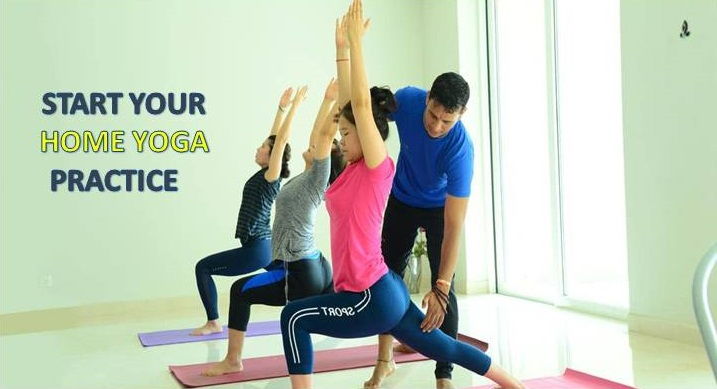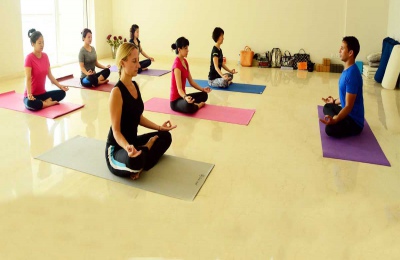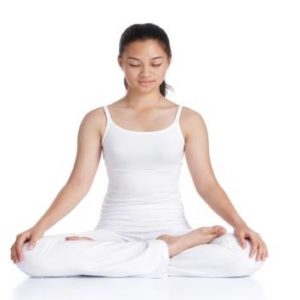Top 10 Excellent Benefits of Padmasana Lotus Pose
Originating in meditative practices of India, Padmasana is a cross-legged yoga posture. The arrangement of hands and feet in the lotus pose resemble a lotus flower– symbolizing divine beauty and purity. Padmasana is an archetypal yoga asana having the unbound potential to calm the nerves, to awaken the energy, and to blossom you beautifully.
Sage Vyasa refers to Lotus Pose as one of the important among the Virasana (Hero Pose), Dandasana (Staff Pose) that can facilitate Meditation and Pranayama. The classical text of Hatha Yoga Pradipika calls Padmasana the ‘Destroyer of Diseases.’ The Gheranda Samhita and Shiva Samhita tell the readers to sit in Lotus Pose for mastering the Pranayama.
How To Do Padmasana (Lotus Pose)?
1. Start in the Staff Pose (Dandasana). Back and legs Straight, palms on the floor, and eyes fixed at a point in front.
2. Cross the left leg over the right with the left foot in the right hip crease. Now, place the right leg over the left and find the other hip crease for locating the foot.
3. Fold the hands in Anjali Mudra or Jnana Mudra (thumbs and index fingers touching).
Deepen the Pose:
Practitioners sitting in Padmasana for meditation and yogic breathing practices are advised to alternate the cross of the legs daily. One easy way to remember this is to bring in front the right leg on even-numbered days and left on odd-numbered ones.
Top 10 Excellent Benefits of Lotus Pose
1. Increased Blood Supply to Abdomen: Owing to the crossed-legged position of the lotus asana, the blood supply is decreased in the legs and is redirected to the abdominal organs. The enhanced blood flow in the abdominal region is highly beneficial for the organs and intestines. The improvement in digestion can be experienced as one of the charming health benefits of Padmasana. The nerves emanating from the coccyx and sacrum also receive a healthy influence from the increased blood supply.
2. Eased Menstruation and Childbirth: The practice of Lotus Pose in the menstruation week can help ease cramping, bloating, fatigue, etc., making it less painful. The pose strengthens the core, back, and opens the hips– the points of discomfort during menstruation. Padmasana is a beautiful pose to practice in the early months of pregnancy as it prepares you for the childbirth by stretching the pelvic floor muscles and softening the vaginal opening.
3. Activated Lymph Nodes: A wonderful asana to practice if you are feeling the symptoms of a cold or are under the weather. With the cross engagement of the legs in the pose, the heels are pressed into the hip joints– where lymph nodes are located. The pressure applied stimulates the lymph nodes helping the lymphatic system push out the toxins and giving immunity a boost.
4. Released Hips: The body initiates a fight or flight response when they encounter stress. Hips are no exception. The tight hips indicate emotional blockages and tension. The built-up stress, anger, guilt– everything is stored in our hips. The Hip-Opening posture– Lotus pose is effective in releasing the emotions and helps to undo the layers of damage.
5. Connect To Root Chakra: The root chakra lies at the base of the spine and is home to the feelings of fear, isolation, how we perceive our body image, and physical health. The imbalanced root chakra fosters sensations of depression, loneliness, and even constipation. The Lotus Yoga Asana balances the Root Chakra making us feel secure, happy, and connected to our lives.
6. Awakens the Kundalini Nadi: The position of the body in the Padmasana activates the Nadi, especially the Sushumna Nadi. Through Sushumna Nadi, the Kundalini flows. Since this energy channel is activated, Kundalini can be awakened, unfolding the higher potentials of the human beings.
7. Acupuncture Points: In the lotus pose, the various parts of the body press into the acupuncture points of the stomach, kidneys, spleen, etc., changing the metabolic rate and brain patterns for bringing balance.
8. Calms the Brain: By awakening the energies, balancing the chakras, and strengthening the body organs, the lotus pose makes way for calming the brain. Also, the grounding of the pelvis to the floor stimulates the nerves in the sacrum that triggers the parasympathetic nervous system producing a calming effect.
9. Attain a Meditative State: Lotus Posture is a highly calming, energizing, and stabilizing pose. It encourages proper posture and spinal alignment facilitating deep breathing and attainment of a meditative state.
10. Embrace Transformation: The lotus pose bestows the practitioners with numerous physical and energetic benefits aiding in positive health transformations.
Blossom with health and vitality with a regular practice of Padmasana (Lotus Pose)
Meet Our Yoga Teachers

Devender Bhardwaj

Kulwant

Gabriele (Gaby) Alscher

Amit Kumar
Blog Post
How to find the best yoga teacher training in Gurgaon
Learning yoga is a life-changing experience that would let you view the world with a different lens. It aims at self-...

Which yoga style works best for your needs
Yoga is an ancient practice, which has its roots in India. The essential role of yoga is to create a powerful and mea...

How to Find the Best Yoga Center in Gurgaon
Gurgaon is widely defined as one of the financial, technological, and industrial hubs of the country. Gurgaon is also...

Aumyogashala 5th International Yoga Day Celebration
International Yoga Day is celebrated every year on the 21st of June to raise awareness among people about the benefit...


